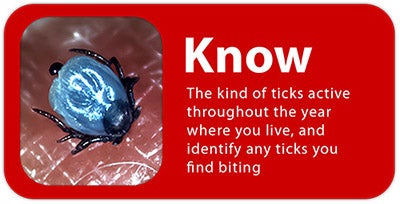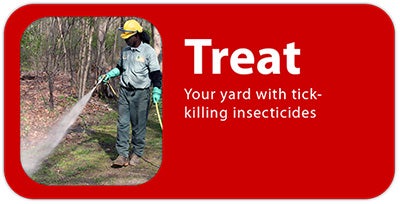Keep your family and your pets safe from ticks with these simple steps.

1. Know
Know the kind of ticks active throughout the year where you live, and identify any ticks you find biting.
Learn what stage tick it is (larva, nymph, adult, partially fed, fully fed). Determine whether a certain tick has the potential to transmit disease and it’s seasonal activity patterns. Be prepared for your next trip into tick habitat with our Current Tick Activity application.

2. Perform
Perform daily tick checks, especially below the belt, for tiny nymph ticks.
Protect yourself and your family with proven strategies to prevent tick bites. Clothing-only repellents and daily checks are among the most effective to prevent yourself from getting a tick-borne disease.

3. Turn
Turn ordinary clothes into tick repellent ones, even from play clothes and other outdoor clothes.
Wearing tick repellent clothing is the best– and easiest –way for people to prevent tick bites when they venture outdoors. Did you know you can turn your own favorite clothes into tick repellent clothes? Your comfortable gardening pants, lucky golf shorts, hiking socks, everything for the kids to take to summer camp….all professionally treated with an invisible, odorless, EPA registered, tick repellent (permethrin) that remains effective through 70 washes!

4. Treat
Treat your yard with tick-killing insecticides.
The single most effective way to reduce blacklegged (deer) ticks in your yard is by insecticide applications that are applied mainly to the yard perimeter, shady perennial beds or along trails and paths in woods. Perimeter spray treatments are eco-friendly by limiting the amount of pesticide being applied, and targeting the areas where people most frequently come into contact with deer ticks.

5. Protect
Protect your pet using products with rapid kill or knock-down.
Pets are important to your family, and protecting them from tick-bites and tick-borne disease should be part of your tick bite prevention program. Not only do you want to keep your pets healthy, but dogs and cats that roam in tick areas can be a risk to your family by bringing ticks to you when you least expect it.
